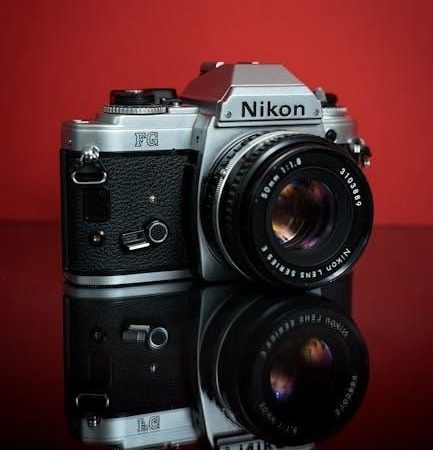Pandigital Digital Photo Frame⁚ A Comprehensive Guide
This guide provides a complete walkthrough of your Pandigital digital photo frame. Learn to set it up, connect memory devices, navigate menus, view photos and videos (if applicable), utilize advanced features, troubleshoot problems, and maintain its longevity. Find additional support and safety precautions included.
Congratulations on your new Pandigital digital photo frame! This guide will help you get started. Carefully unpack your frame, ensuring all components are present⁚ the frame itself, power adapter, remote control (if included), and any additional accessories. Check for any physical damage to the frame before proceeding. The included manual might offer specific model-dependent instructions; however, this guide provides general setup steps applicable to most Pandigital models. Inside the box, you should find the main unit, a power cord, and possibly a remote control depending on the model. Ensure the power adapter is correctly connected to both the frame and a power outlet. Familiarize yourself with the frame’s exterior, noting the buttons for navigation, power, and any other controls. Before plugging it in, inspect the power cord and adapter for any damage. If you find any defects, contact customer support immediately.
Setting Up Your Pandigital Photo Frame
Once unpacked and inspected, connect the power adapter to the frame and a power outlet. The frame should power on, displaying an initial setup screen or a welcome message. Follow the on-screen prompts to set the language, date, and time. Most Pandigital frames offer simple menu navigation using buttons on the frame itself or a remote control (if included). You might need to adjust the display brightness and contrast to suit your viewing environment. The initial setup may also include options for selecting preferred slideshow transitions, music playback, and other visual settings. Take your time to explore the menu options and personalize your frame’s appearance. If you encounter any difficulties during the initial setup, consult the included quick start guide or the comprehensive user manual for detailed instructions. The frame may automatically detect the time zone based on your location or you may need to manually set it. Pay close attention to the on-screen instructions; each step is usually clearly explained. If the frame fails to power on, check the power cord and outlet to make sure they are functioning correctly.
Connecting Memory Cards and USB Drives
To add your cherished memories to your Pandigital frame, locate the card slot and/or USB port, usually situated on the side or back of the device. Consult your user manual for the exact location and supported formats. Commonly accepted formats include SD cards, MMC cards, and USB flash drives. Gently insert your memory card into the designated slot, ensuring it clicks into place. For USB drives, plug it firmly into the USB port. The frame should automatically detect the connected device and display its contents. If not, navigate to the “Media” or “Photo” menu option, and select the relevant source. Ensure that your photos and videos are stored in compatible file formats like JPEG, MP3, and MPEG. If you encounter file format incompatibility issues, convert your files to supported formats using appropriate software before transferring them. The frame’s capacity to display and manage files depends on the model and its internal memory; some may require a higher-speed SD card for smooth slideshows. Always safely remove the memory card or USB drive before disconnecting it from the frame, to avoid data corruption or loss. After inserting your media, wait a moment for the frame to index the files before viewing your content. If the frame doesn’t recognize your device, restart the device.
Navigating the Menu System and Controls
Your Pandigital photo frame’s menu system is designed for intuitive navigation. The main controls are typically located on the frame itself or via a supplied remote control. A directional pad (up, down, left, right) allows for easy movement through menus and options; A “Select” or “OK” button confirms choices, while a “Back” or “Return” button allows you to go back to previous screens. The menu structure usually includes options for photo viewing (slideshows, individual photos), music playback (if supported), video playback (if supported), and settings adjustments. The settings menu often includes options for screen brightness, display timeout, slideshow transition effects, and clock/calendar settings. Familiarize yourself with the on-screen prompts and icons, which provide visual cues for navigating the system. The remote control, if included, enhances control and comfort; Remember that the exact layout and functionality of the menu system might vary depending on your specific Pandigital photo frame model. Always refer to your user manual for detailed instructions and explanations for your particular model. If you encounter any difficulties while navigating the menu, consult the troubleshooting section of your manual or seek online support from Pandigital’s website or user forums.
Viewing Photos⁚ Slideshows and Individual Displays
Displaying your cherished memories on your Pandigital frame is effortless. To initiate a slideshow, simply insert your memory card or USB drive containing your photos. The frame will automatically begin playing a slideshow, transitioning between images with various effects (depending on your settings). You can usually customize these transition effects within the frame’s settings menu, choosing from fades, wipes, or other animations. For individual photo viewing, navigate to the desired image within the photo browsing menu, typically using the directional buttons on the frame or remote. Once selected, the photo will display in full-screen mode. Many Pandigital models offer zoom functionality, allowing you to enlarge portions of the image for closer inspection. Use the zoom controls (usually on the remote) to magnify or reduce the image size. You can usually rotate photos if they are displayed incorrectly. Remember that image display quality depends on the resolution and format of your images; high-resolution images generally look sharper and clearer. Navigation through your photo collection is simplified; use the menu controls to move between photos, select specific albums or folders, or shuffle the order for a randomized slideshow. Explore the settings menu to adjust the slideshow speed, transition effects, and even add background music if your model supports it.
Playing Music and Videos (If Supported by Model)
Enhance your viewing experience by incorporating music and videos (if your Pandigital model supports these features). Many Pandigital frames offer media playback capabilities beyond just still images. To play music, simply connect a USB drive or memory card containing your music files to the frame. The frame will typically detect and automatically begin playing the music files in the order they appear. You can usually control playback functions such as play, pause, skip, and stop using the buttons on the frame itself or via the remote control. Similarly, to play video files, ensure that the connected media contains compatible video formats and resolutions. Your frame’s manual should list the supported video formats; common formats include AVI, MP4, and MOV. The playback controls for videos usually mirror those for music. Note that video playback may be affected by the frame’s processing power and the quality of your video files. Higher-resolution videos may require more processing power, potentially leading to slightly slower playback or even buffering. If your Pandigital frame supports background music playback, you can enjoy a soundtrack while viewing your photos. Navigate to the music player within the frame’s menu, select a song or playlist, and start the playback. The audio will play in the background while the slideshow continues, creating an enriched visual and auditory experience.
Advanced Features⁚ Clock, Calendar, and Other Settings
Beyond basic photo viewing, your Pandigital digital photo frame likely offers a range of customizable settings to personalize your experience. Many models include a built-in clock and calendar display, providing a practical use beyond just showcasing photos. Access these features through the main menu; you’ll typically find options to adjust the time, date, and time zone. Some models even allow you to select different clock and calendar display formats (e.g., 12-hour vs. 24-hour time, different date formats). Explore the settings menu for additional options, such as adjusting the brightness, contrast, and color saturation of the screen. These settings can be particularly useful for optimizing the display in different lighting conditions. You might also find options to adjust the slideshow transition effects, such as the speed of transitions between photos or the type of transition used (fade, slide, etc.). Check for options related to power management, allowing you to configure the frame to automatically power down after a period of inactivity to conserve energy. Some models offer the ability to set up a screensaver, enabling you to display a customized image or pattern when the frame is idle. Remember to consult your specific Pandigital model’s user manual for detailed instructions and specific settings available, as features can vary across different models.
Troubleshooting Common Issues
If your Pandigital digital photo frame encounters problems, this section offers solutions to common issues. A blank screen might indicate a power problem; check the power cord connection and ensure the outlet is functioning. If photos don’t display, verify the memory card or USB drive is correctly inserted and formatted compatibly with the frame. Consult your manual for supported file types and formats. If the slideshow isn’t working, check the slideshow settings within the menu, ensuring it’s enabled and configured correctly. A frozen screen might necessitate a power cycle⁚ unplug the frame, wait a few seconds, and plug it back in. If the frame doesn’t recognize a memory card or USB drive, try a different card or drive to rule out a faulty device. Ensure the files on the memory card or drive are properly formatted and not corrupted. If you’re having trouble navigating the menu, refer to your frame’s user manual for guidance on using the remote control or on-screen buttons. For audio or video playback issues (if applicable), make sure the files are in a compatible format and that the volume is adjusted appropriately. If you’ve tried these steps and the problem persists, consider contacting Pandigital customer support for further assistance or referring to their online resources for troubleshooting help. They may have specific advice for your model. Remember to always back up important photos before troubleshooting.
Maintaining Your Photo Frame⁚ Cleaning and Care
Proper care ensures your Pandigital digital photo frame’s longevity and optimal performance. Regular cleaning prevents dust accumulation and maintains image clarity. To clean the screen, gently wipe it with a soft, lint-free microfiber cloth. Avoid using harsh chemicals, abrasive cleaners, or excessive moisture, as these can damage the screen’s surface. For stubborn smudges, slightly dampen the cloth with distilled water, ensuring it’s not overly wet; Never spray liquids directly onto the screen. Clean the frame’s casing using a slightly damp cloth, again avoiding harsh chemicals. If necessary, use compressed air to remove dust from the vents and other hard-to-reach areas. Always unplug the frame from the power source before cleaning to prevent electrical hazards. When not in use, store the frame in a cool, dry place, away from direct sunlight and extreme temperatures. Avoid placing the frame in areas with excessive dust or humidity. Regularly check the memory card and USB drive connections to ensure they are clean and free of debris. Handle the memory cards and USB drives carefully to prevent data loss or damage. By following these simple cleaning and care instructions, you can help ensure your Pandigital photo frame remains in excellent condition for years to come, providing you with years of enjoyment viewing your cherished memories.
Where to Find Additional Support and Resources
Should you require further assistance beyond this manual, several resources are available. Pandigital’s official website may house FAQs, troubleshooting guides, and updated firmware. Searching their support section or utilizing their online search function can often resolve common issues. Remember to specify your photo frame model number for accurate results. Online forums and communities dedicated to digital photo frames or electronics in general can provide peer-to-peer support. Users often share tips, tricks, and solutions to problems encountered. Review sites and user feedback can offer insights into the frame’s functionality and common problems. While user reviews are subjective, they can highlight potential issues or positive aspects you may not have considered. If you purchased your frame from a retailer, check their website or contact their customer support for assistance. They may provide specific troubleshooting guidance or warranty information. Finally, consider contacting professional electronics repair services if you suspect a hardware malfunction. They can diagnose and fix problems beyond the scope of user troubleshooting. Remember to always back up your photos regularly to prevent data loss.
Safety Precautions and Warnings
Prior to operating your Pandigital digital photo frame, carefully review these safety precautions. Never attempt to disassemble the frame yourself; internal components may pose a risk of electric shock. Always use the provided power adapter; using an incompatible adapter may damage the device or create a fire hazard. Keep the frame away from sources of excessive heat, moisture, or direct sunlight. Extreme temperatures can negatively affect its functionality and lifespan. Ensure proper ventilation around the frame to prevent overheating. Avoid placing the device in unstable locations where it could fall and cause injury or damage. Handle the frame gently; dropping it or subjecting it to harsh impacts can lead to internal damage. Never insert or remove memory cards or USB drives while the frame is powered on; this can cause data corruption or damage to the device. If you encounter any issues such as unusual noises, overheating, or strange odors, immediately unplug the power cord and cease operation. Contact customer support or a qualified technician to assess the problem. Keep the frame away from children and pets to prevent accidental damage or injury. Regularly clean the screen with a soft, lint-free cloth to prevent dust and smudges from accumulating. Avoid using harsh chemicals or abrasive cleaners that could damage the screen’s surface. Consult your user manual for specific cleaning instructions.


